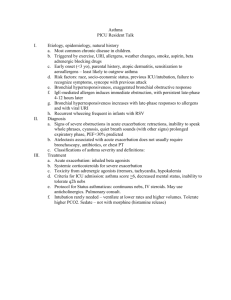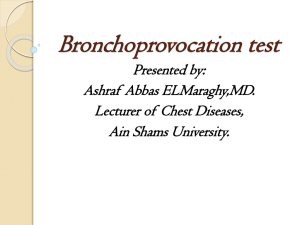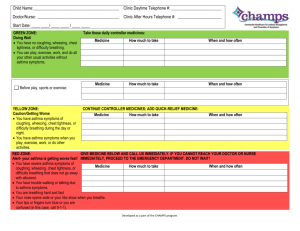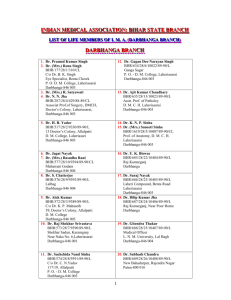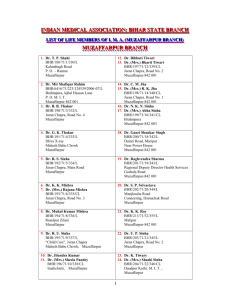3. Use and Misuse of Bronchial Hyperreactivity Measurements in
advertisement
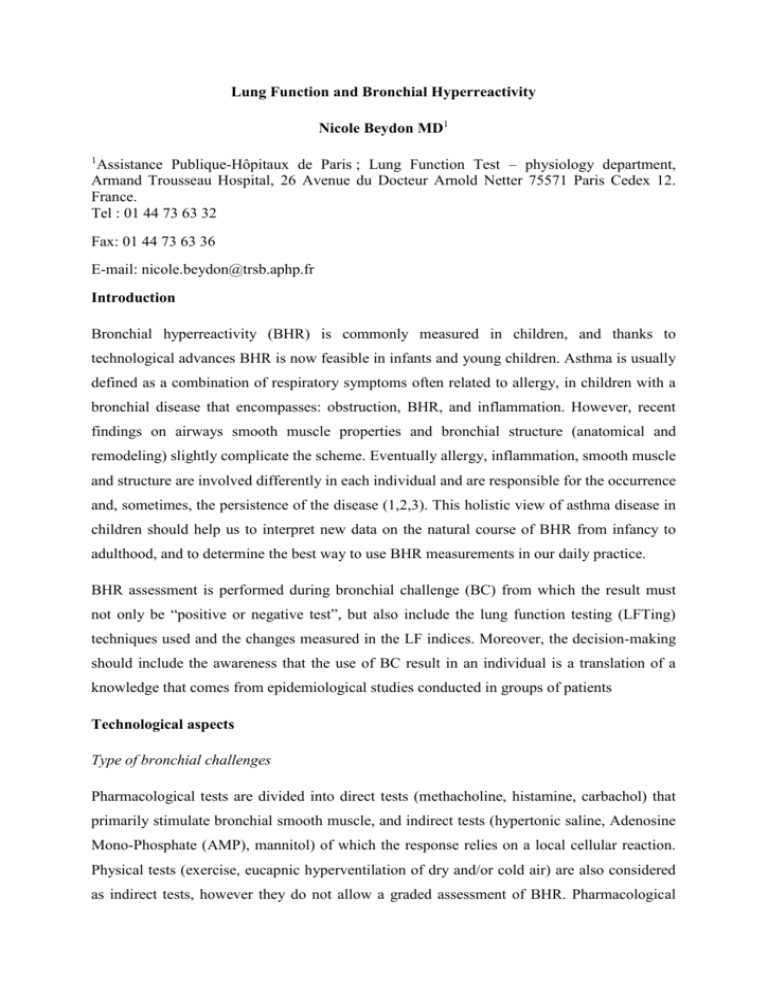
Lung Function and Bronchial Hyperreactivity Nicole Beydon MD1 Assistance Publique-Hôpitaux de Paris ; Lung Function Test – physiology department, Armand Trousseau Hospital, 26 Avenue du Docteur Arnold Netter 75571 Paris Cedex 12. France. Tel : 01 44 73 63 32 1 Fax: 01 44 73 63 36 E-mail: nicole.beydon@trsb.aphp.fr Introduction Bronchial hyperreactivity (BHR) is commonly measured in children, and thanks to technological advances BHR is now feasible in infants and young children. Asthma is usually defined as a combination of respiratory symptoms often related to allergy, in children with a bronchial disease that encompasses: obstruction, BHR, and inflammation. However, recent findings on airways smooth muscle properties and bronchial structure (anatomical and remodeling) slightly complicate the scheme. Eventually allergy, inflammation, smooth muscle and structure are involved differently in each individual and are responsible for the occurrence and, sometimes, the persistence of the disease (1,2,3). This holistic view of asthma disease in children should help us to interpret new data on the natural course of BHR from infancy to adulthood, and to determine the best way to use BHR measurements in our daily practice. BHR assessment is performed during bronchial challenge (BC) from which the result must not only be “positive or negative test”, but also include the lung function testing (LFTing) techniques used and the changes measured in the LF indices. Moreover, the decision-making should include the awareness that the use of BC result in an individual is a translation of a knowledge that comes from epidemiological studies conducted in groups of patients Technological aspects Type of bronchial challenges Pharmacological tests are divided into direct tests (methacholine, histamine, carbachol) that primarily stimulate bronchial smooth muscle, and indirect tests (hypertonic saline, Adenosine Mono-Phosphate (AMP), mannitol) of which the response relies on a local cellular reaction. Physical tests (exercise, eucapnic hyperventilation of dry and/or cold air) are also considered as indirect tests, however they do not allow a graded assessment of BHR. Pharmacological tests are more often used because they require minimal cooperation from the child and, therefore, can be implemented in all age groups. Exercise tests are commonly used in children with respiratory complain on exertion. Age of the patient The LFT techniques used in paediatric population have to be adapted to the child’s age and maturity, which leads to consider cooperative and non cooperative children. The former are explored as adults, whereas the latter are tested using specific techniques. As a result, young children who require a BC should be referred to a Lab that routinely use techniques adapted to the young children and handled by a trained staff. Children of more than 6 years of age are thought to be able to perform LFT like adults do. But in practice, and particularly for long duration test like BC, before 8 to 10 years of age some children can show a large variability in spirometry results (4) or sometimes completely lose interest as the test proceeds, providing no final result. It is the technician’s ability to detect children with short concentration span that warrants the reliability of the test. Indeed, a submaximal forced expiration maneuver in the course of a BC must not be interpreted as bronchoconstriction. In that case, additional techniques usually used in children younger than 6 years have to be used (see below). However, in school age children and adolescents, spirometry is the recommended technique to measure BHR, with the same cutoffs than the ones used in adults (5). The cutoff for a positive response to direct pharmacological tests is a 20% baseline decrease in Forced Expiratory Volume in 1 s (FEV1), and a positive response to indirect tests a 15% baseline decrease in FEV1. The preschool children are known as the difficult ones, because they have to be tested awake but might be reluctant to participate in the test if not correctly supervised. Once again, trained staff and a welcoming lab (decorating colors, posters, games, adapted furniture…) are mandatory to gain the child’s confidence and collaboration. The techniques used to assess BHR in this age group are direct measurements of bronchial obstruction (resistance measurement, wheezing detection) or measurements of induced ventilation-perfusion mismatch (transcutaneous partial pressure of oxygen (TcPO2), percutaneous oxygen saturation (SpO2))(6,7,8). The cutoff for a positive bronchial response is a 20% or a 5% baseline decrease in TcPO2 or in SpO2, respectively, or a SpO2<91% during the test or the occurrence of wheezing (9,10,11). Concerning resistance techniques, no cutoff has been agreed upon, and a less than 35% increase cannot be considered as a positive response. However, for safety reasons, the use of concomitant alternative techniques (auscultation, assessment of hypoxemia) are recommended when using resistance techniques, because false negative tests can occur (7,12,13,14). Spirometry has been used in preschool children with asthma or chronic cough but not in healthy ones (15,16). A 20% decrease in FEV1 was found a more sensitive endpoint than wheezing occurrence, and a 25% decrease in FEV0.5 which could distinguish between children with asthma and children with chronic cough, was proposed as an even better endpoint. However, studies in healthy preschool children are necessary before stating the diagnosis relevance of these cutoffs (16).The preschool children can easily be tested during pharmacological tests or physical tests such as cold air challenge (17,18). Exercise tests are more difficult to conduct in young children, because it is difficult to achieve maximal effort in a number of children (19) and because no studies have established relevant lung function cutoff in this setting. Infants are tested during induced sleep using pharmacological tests (nebulized drugs) and bronchial reactivity is assessed by TcPO2 and/or maximal expiratory flow decreases. In the absence of consensus, a 15% baseline decrease in TcPO2 has been used to define a positive test, or a 40% baseline decrease in maximal flow at Functional Residual Capacity (VmaxFRC) (20) or a 30% baseline decrease in FEF75 (21). Interpretation of the results The response to pharmacological direct tests is graded, and the occurrence of BHR for a low dose of pharmacological agent is interpreted as severe BHR. Conversely, most of the indirect pharmacological tests and physical tests give a binary (positive or negative) response. Results from different types of test are not interchangeable. In children with asthma, BC are generally positive because smooth muscle hyperreactivity and bronchial inflammatory cells are present. However, there are some situations such as post-infectious bronchiolitis obliterans, chronic lung disease where only smooth muscle hyperreactivity is present so that direct BC are more likely to be positive than indirect BC (22,23,24). Moreover, in groups of asthmatic children equally responsive to methacholine, atopy is the most important predictive factor for AMP responsiveness (25,26). Finally, asthmatic children are prone to exhibit BHR to methacholine and to exercise challenges (direct and indirect tests), but the methacholine challenge is far more frequently positive than the exercise test, assuming a different pathophysiology of the two tests (27). In children, most of our knowledge comes from studies on direct pharmacological tests. Clinical aspects Epidemiological studies on BHR recorded in populations with different health status are helpful to understand the relationship between BHR and respiratory symptoms. However, it might be difficult to implement results from cohort studies in daily practice. The issues that might be worth elucidating are: to which child a BC can be useful? how the result should be interpreted? in which way BC result can interfere with the child’s respiratory symptoms treatment and/or development? Cohort studies Despite the strong relationship that exists between asthma and BHR in children, BHR is not synonymous to asthma and vice versa. For example, current atopy and early lower respiratory tract illness are good, independent from asthma predictors for BHR in children 11 years of age (28). However, most children with current asthma exhibit BHR and the usefulness of BC in asthmatic children must be questioned. Until now, even though the inhaled corticosteroids (ICS) dose-dependent improvement of BHR to methacholine has been suggested (29), there are no recommendations to adapt asthmatic children’s ICS treatment to the presence or to the level of BHR. Such a position is strengthened by the result of the CAMP study that showed, over a 4 years follow-up, the independent relationship between low level of BHR to methacholine and lung function improvement in the children receiving placebo or nedocromil, but not in those receiving ICS (30). However, the children had all BHR (at entry in the study) with mild to moderate asthma, and a disease lasting for an average of 5 years; therefore, the study did not address newly diagnosed or severe asthmatic children nor did it compare results from children with and without BHR. In another study on early ICS treatment in wheezy infants (IFWIN study), BHR measured during eucapnic hyperventilation challenge at 5 years of age did not differ between ICS and placebo groups, despite a clinical improvement due to ICS use (31). Therefore, BC might not be helpful in handling asthmatic children’s therapy, but could be more useful to diagnose bronchial disease in children with respiratory symptoms but no asthma or wheeze. The rationale to do so relies on the results of longitudinal studies conducted in children with and without BHR. For example, in a cohort from New Zealand, the presence of asymptomatic BHR at 9 years of age was highly, and increasingly over time, correlated with the occurrence of asthma, wheezing, or atopy markers up to the age of 26 years (32). After taking into account all outcomes related to symptoms, asymptomatic BHR remained independently associated to asthma, chest tightness, and cough during or after running. Interestingly, cough or phlegm production were not associated with BHR, in line with a previous study in which there was an association between wheeze and BHR at age 7 to 11, but no association between BHR and cough or chest tightness in the absence of wheeze (33). From these studies, BHR is more related to asthma or wheeze than to non specific respiratory symptoms, and BHR in children is likely to precede asthma symptoms, particularly if it is a long standing bronchial characteristic. But wheeze can occur very early in life, and the relationship between wheeze in infants and subsequent BHR has been studied in a cohort from United-Kingdom (ALSPAC study)(34). The level of BHR in childhood (7 to 9 years of age) was highest in the children that begun to wheeze after 18 months of age compared to children of other wheezing phenotype groups (particularly early wheezers). However, BHR was related to all wheezing phenotypes compared to the never or infrequent wheeze. The authors concluded that some early environmental influences may play a role in the development of later BHR, wheeze and atopy. The timing of BHR then seems crucial, and as suggested by this study, the later the wheeze during infancy the higher the BHR in childhood. The next step was to explore BR before the occurrence of respiratory symptoms. In 176 unselected Australian newborns, histamine challenges were performed at 1, 6 and 12 months of age (35). Wheeze at age 11 years was correlated to a higher level of bronchial reactivity at 12 months of age, but not at 1 or 6 months of age, and asthma or wheeze was never present in children without BHR at both 12 months and 11 years of age. Persistence of BHR beyond infancy was significantly more frequent in children with at least one parent with asthma, or with personal history of lower respiratory tract illness in the first 6 months of life, or with atopy in childhood, but not in those whose mother smoked during pregnancy. Finally, the study children could change bronchial reactivity pattern during the follow-up, and among the 122 children with BHR during infancy, 50% did not display BHR any longer at 11 years of age. Thus, this study confirms the importance of the timing for BHR in infancy for future asthma, and the later the BHR in infancy the higher the risk to wheeze during childhood. The progression of BHR and symptoms entails a loss of BHR in wheezy infants who will grow out of the wheezing disease. In line with these results, in the cohort from Isle of Wright, a similar level of bronchial reactivity at 10 years of age was evidenced between healthy and early transient wheezers on the one hand, and between persistent and late-onset wheezers on the other hand (36). These cohort studies are in favor of BHR being a marker for asthma/wheeze when present and persisting early in life, under genetic (atopy) and environmental (infection) determinants, with little influence of ICS treatment. Clinical applications The use of a BC result in clinical setting requires that the test be performed accordingly to the current knowledge on LFT in children (cf paragraph “technological aspects”). From the previous discussion on BHR and asthma/wheeze symptoms, we suggest that the relevance for BHR measurement in a child is as follows: 1) if a child has current wheezing that respond to asthma medication, then BC test will not add any information on the child’s respiratory disease or treatment, outside the field of research, 2) if a child has non-specific respiratory symptoms beyond infancy, the diagnosis procedure may include a BC. If BHR is detected (and even more if BHR is repeatedly present or present after the preschool years) then the respiratory symptoms can be interpreted as precursors of asthma disease or as a variant to typical asthma symptoms, especially if the child has atopy and/or a history of lower tract illness during early infancy. Anti-asthmatic medication should be considered in the child to cure his/her respiratory symptoms. 3) for wheezy infants, the frequency of respiratory symptoms and of BHR that will not stand beyond this period of life preclude any definitive conclusion from a BC which should, therefore, be performed only in difficult-to-treat infants with uncertain diagnosis and in specialized centers. Conclusion In conclusion, BHR can be monitored from birth to childhood for clinical or research purposes. In clinical practice, the result of a BC cannot be interpreted without taking into account the child’s personal and familial history and the clinical presentation of the disease. Reference 1. Brown RH, Mitzner W. Functional imaging of airway narrowing. Respir Physiol Neurobiol. 2003;137:327-337. 2. Crimi E, Spanevello A, Neri M, Ind PW, Rossi GA, Brusasco V. Dissociation between airway inflammation and airway hyperresponsiveness in allergic asthma. Am J Respir Crit Care Med. 1998;157:4-9. 3. Laprise C, Laviolette M, Boutet M, Boulet LP. Asymptomatic airway hyperresponsiveness: relationships with airway inflammation and remodelling. Eur Respir J. 1999 ;14:63-73. 4. Stanojevic S, Wade A, Cole TJ, et al. Spirometry centile charts for young Caucasian children: the Asthma UK Collaborative Initiative. Am J Respir Crit Care Med. 2009;180:547-552. 5. Crapo RO, Casaburi R, Coates AL, et al. Guidelines for methacholine and exercise challenge testing-1999. This official statement of the American Thoracic Society was adopted by the ATS Board of Directors, July 1999. Am J Respir Crit Care Med. 2000 ; 161:309-329. 6. Avital A, Bar-Yishay E, Springer C, Godfrey S. Bronchial provocation tests in young children using tracheal auscultation. J Pediatr. 1988;112:591-594. 7. Beydon N, Davis SD, Lombardi E, et al. An official American Thoracic Society/European Respiratory Society statement: pulmonary function testing in preschool children. Am J Respir Crit Care Med 2007;175:1304-1345. 8. Bisgaard H, Nielsen KG. Plethysmographic measurements of specific airway resistance in young children. Chest. 2005;128:355-362. 9. Holmgren D, Engstrom I, Bjure J, Sixt R, Aberg N. Respiratory resistance and transcutaneous PO2 during histamine provocation in children with bronchial asthma. Pediatr Pulmonol. 1993;15:168-174. 10. Holmgren D, Redfors S, Wennergren G, Sten G. Histamine provocation in young, awake children with bronchial asthma, using a fall in oxygenation as the only indicator of a bronchial reaction. Acta Paediatr. 1999;88:545-549. 11. Godfrey S, Uwyyed K, Springer C, Avital A. Is clinical wheezing reliable as the endpoint for bronchial challenges in preschool children? Pediatr Pulmonol. 2004;37:193200. 12. Phagoo SB, Wilson NM, Silverman M. Evaluation of a new interrupter device for measuring bronchial responsiveness and the response to bronchodilator in 3 year old children. Eur Respir J. 1996;9:1374-1380. 13. Wilson NM, Bridge P, Phagoo SB, Silverman M. The measurement of methacholine responsiveness in 5 year old children: three methods compared. Eur Respir J. 1995; 8:364-370. 14. Beydon N, Trang-Pham H, Bernard A, Gaultier C. Measurements of resistance by the interrupter technique and of transcutaneous partial pressure of oxygen in young children during methacholine challenge. Pediatr Pulmonol. 2001;31:238-246. 15. Bentur L, Beck R, Elias N, Barak A, Efrati O, Yahav Y, Vilozni D. Methacholine bronchial provocation measured by spirometry versus wheeze detection in preschool children. BMC Pediatr. 2005;5:19. 16. Vilozni D, Livnat G, Dabbah H, Elias N, Hakim F, Bentur L. The potential use of spirometry during methacholine challenge test in young children with respiratory symptoms. Pediatr Pulmonol. 2009;44:720-727. 17. Nielsen KG, Bisgaard H. Lung function response to cold air challenge in asthmatic and healthy children of 2-5 years of age. Am J Respir Crit Care Med. 2000;161:1805-1809. 18. Nielsen KG, Bisgaard H. Hyperventilation with cold versus dry air in 2- to 5- year-old children with asthma. Am J Respir Crit Care Med. 2005;171:238-241. 19. Vilozni D, Bentur L, Efrati O, et al. Exercise challenge test in 3- to 6-year-old asthmatic children. Chest 2007 ;132:497-503. 20. Turner SW, Palmer LJ, Rye PJ, et al. The relationship between infant airway function, childhood airway responsiveness, and asthma. Am J Respir Crit Care Med. 2004 ;169:921-927. 21. Tepper RS, Williams-Nkomo T, Martinez T, Kisling J, Coates C, Daggy J. Parental smoking and airway reactivity in healthy infants. Am J Respir Crit Care Med. 2005;171:78-82. 22. Avital A, Picard E, Uwyyed K, Springer C. Comparison of adenosine 5'- monophosphate and methacholine for the differentiation of asthma from chronic airway diseases with the use of the auscultative method in very young children. J Pediatr. 1995;127:438-440. 23. Kim DK, Yoo Y, Yu J, Choi SH, Koh YY. Bronchial responsiveness to methacholine and adenosine 5'-monophosphate (AMP) in young children with post-infectious bronchiolitis obliterans. Acta Paediatr. 2006;95:56-61. 24. Kim DK, Choi SH, Yu J, Yoo Y, Kim B, Koh YY. Bronchial responsiveness to methacholine and adenosine 5'-monophosphate in preschool children with bronchopulmonary dysplasia. Pediatr Pulmonol. 2006;41:538-543. 25. Bakirtas A, Turktas I. Determinants of airway responsiveness to adenosine 5'- monophosphate in school-age children with asthma. Pediatr Pulmonol. 2006;41:515-521. 26. Kim DK, Choi SH, Yu J, Yoo Y, Koh YY. Bronchial responsiveness to methacholine and adenosine 5'-monophosphate in atopic and non-atopic preschool children with recurrent wheezing. Clin Exp Allergy. 2007;37:15-21. 27. Clough JB, Hutchinson SA, Williams JD, Holgate ST. Airway response to exercise and methacholine in children with respiratory symptoms. Arch Dis Child. 1991;66:579-583. 28. Turner SW, Palmer J, Rye PJ, et al. Determinants of airway responsiveness to histamine in children. Eur Respir J. 2005 ;25:462-467. 29. Hofstra WB, Neijens HJ, Duiverman EJ, Kouwenberg JM, Mulder PG, Kuethe MC, Sterk PJ. Dose-responses over time to inhaled fluticasone propionate treatment of exercise- and methacholine-induced bronchoconstriction in children with asthma. Pediatr Pulmonol. 2000;29:415-423. 30. Tantisira KG, Fuhlbrigge AL, Tonascia J, et al. Bronchodilation and bronchoconstriction: predictors of future lung function in childhood asthma. J Allergy Clin Immunol. 2006;117:1264-1271. 31. Murray CS, Woodcock A, Langley SJ, Morris J, Custovic A. Secondary prevention of asthma by the use of Inhaled Fluticasone propionate in Wheezy INfants (IFWIN): double-blind, randomised, controlled study. Lancet. 2006;368:754-762. 32. Rasmussen F, Taylor DR, Flannery EM, Cowan JO, Greene JM, Herbison GP, Sears MR. Outcome in adulthood of asymptomatic airway hyperresponsiveness in childhood: a longitudinal population study. Pediatr Pulmonol. 2002;34:164-171. 33. Clifford RD, Howell JB, Radford M, Holgate ST. Associations between respiratory symptoms, bronchial response to methacholine, and atopy in two age groups of schoolchildren. Arch Dis Child. 1989;64:1133-1139. 34. Henderson J, Granell R, Heron J, et al. Associations of wheezing phenotypes in the first 6 years of life with atopy, lung function and airway responsiveness in mid-childhood. Thorax. 2008;63:974-980. 35. Turner SW, Young S, Goldblatt J, Landau LI, Le Souef PN. Childhood asthma and increased airway responsiveness: a relationship that begins in infancy. Am J Respir Crit Care Med. 2009;179:98-104. 36. Kurukulaaratchy RJ, Fenn MH, Waterhouse LM, Matthews SM, Holgate ST, Arshad SH. Characterization of wheezing phenotypes in the first 10 years of life. Clin Exp Allergy. 2003;33:573-578.
